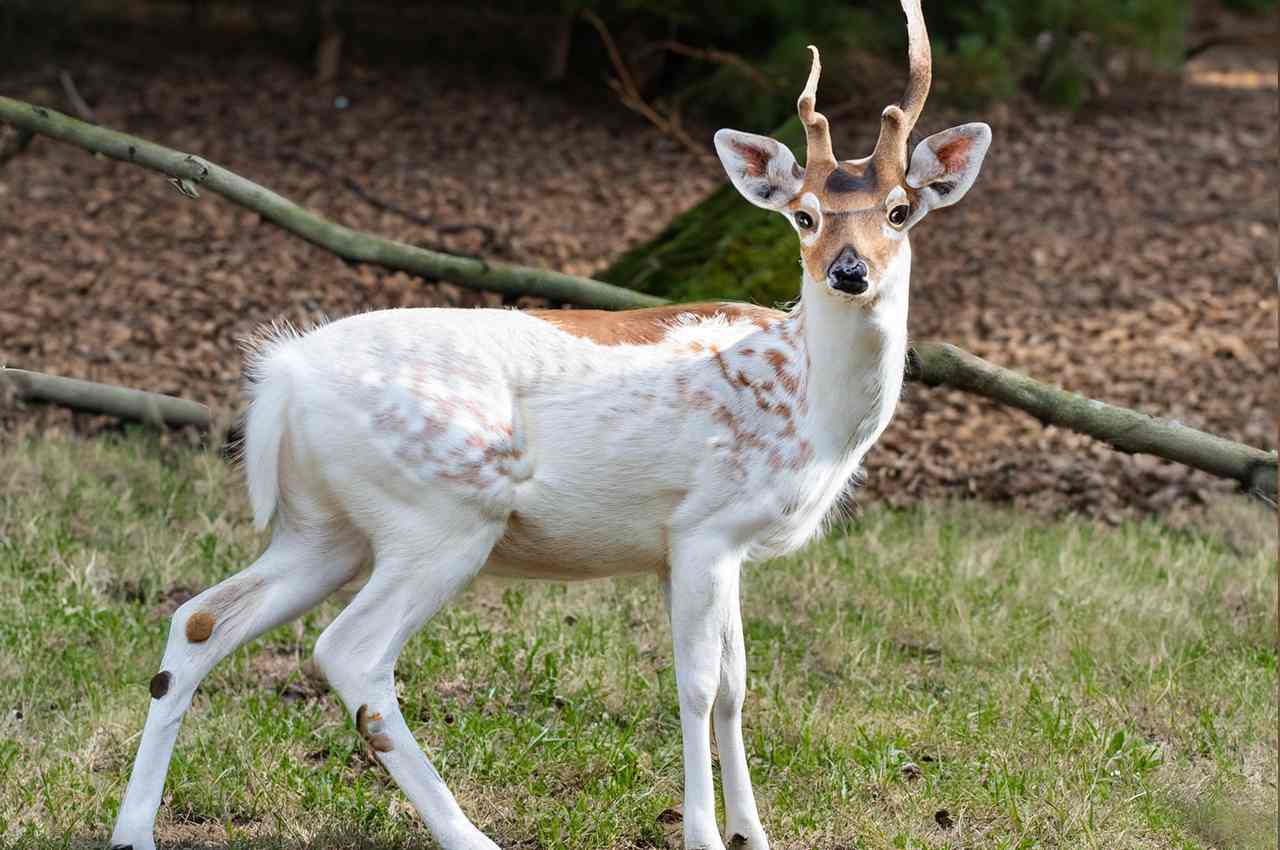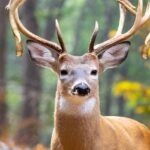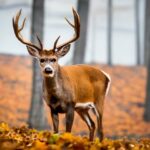Wondering, “What is a piebald deer?” It’s a deer that exhibits a fascinating genetic condition known as piebaldism. Few things in the captivating realm of nature can catch the mind like the piebald deer. Both hunters and nature lovers have always been fascinated and intrigued by these magnificent animals because of their distinctive coat patterns and alluring presence. We shall investigate the genetic roots, physical traits, cultural importance, and even the moral issues surrounding the shooting of piebald deer in order to solve the mystery surrounding them.
Piebald Deer – A Detailed Analysis
Piebald deer have white fur patches and consistently colored hair. Hereditary piebaldism affects the distribution of melanin, the pigment that colors skin, hair, and eyes. A piebald deer’s body might be almost all white or have a few tiny patches. Although their hooves may be white or translucent, their eyes and nose are usually normal.
Piebaldism is not albinism, which lacks melanin. Albinism causes pink noses, eyes, and white fur. Leucism, which causes white, pale, or patchy skin, is different from piebaldism. Although leucistic deer have normal eyes and nostrils, they may have white hair.
Piebald deer are rare yet distributed worldwide. They have been detected in mule deer and elk, although white-tailed deer are more common.
Because piebald deer are more visible to predators, they may have a lower survival rate. Piebald deer are gorgeous and unique, therefore nature enthusiasts enjoy them.
If you see a piebald deer, don’t disturb its area. Piebald deer are wild animals and should not be mistreated.
Additional information on piebald deer is provided below:
- Piebald deer do not belong to a different species of deer. Simply put, they are deer with a genetic abnormality.
- Piebald deer may range in whiteness on their bodies from just a few tiny areas to almost all white.
- The eyes and nostrils of piebald deer are often pigmented.
- Some places have a higher density of piebald deer than others. For instance, they are very typical in several regions of Canada and the United States.
Wildlife lovers often like piebald deer for their distinctive beauty.
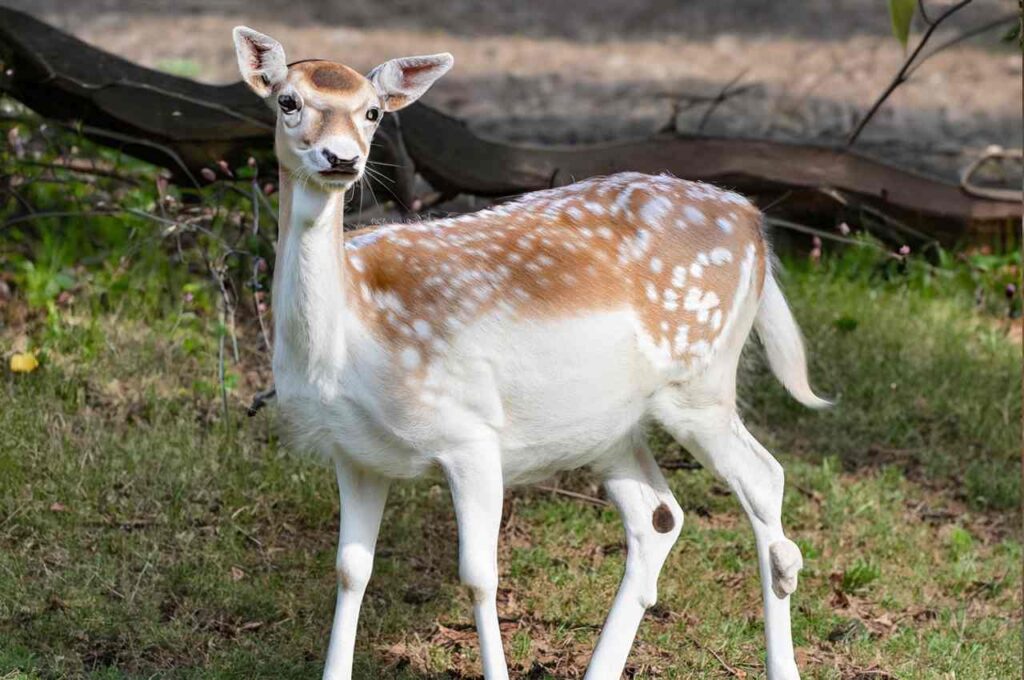
Common Physical Abnormalities in Piebald Deer
| Physical Abnormality | Description |
|---|---|
| Misaligned Spine | Spinal deformities that may affect mobility. |
| Crooked or Shortened Legs | Limb abnormalities that can impact movement. |
| Internal Organ Deformities | Structural issues in internal organs, potentially life-threatening. |
| Extended Jaw Lines | Abnormal jaw structure that can hinder eating. |
Understanding the Piebald Phenomenon
Genetic Origins of Piebaldism
A deer’s characteristic piebald coat pattern is caused by the genetic abnormality known as piebaldism. Piebald deer have a mixture of white and regularly colored fur, unlike animals with albinism, which are completely colorless. Inconsistent pigmentation distribution during embryonic development is the cause of this impressive contrast.
Key Genetic Characteristics of Piebald Deer:
- Genetic Mutation: A genetic mutation that alters the natural distribution of pigmentation in a deer’s coat results in piebaldism.
- Unique Patterns: Piebald deer have a broad variety of coat patterns with different amounts of white and colorful patches.
- Normal Skin Pigmentation: Unlike albinos, piebald deer still have color in their skin and eyes, giving their white fur the appearance of pink or mottled skin.
The Physical Characteristics of Piebald Deer
The remarkable contrast between their white and colorful fur patches gives piebald deer their distinctive look. Piebald deer may have physical anomalies in addition to their distinctive coat patterns, which serve as their primary means of identification.
Physical Characteristics of Piebald Deer:
- Piebald Patterns: A piebald’s distinctive appearance is made up of sporadic white spots on a body that is mostly black in hue.
- Variation in Pigmentation: Different deer have different amounts of white and colorful patches, resulting in a wide variety of piebald patterns.
- Physical malformations: Some piebald deer may be born with physical malformations that might harm their health, such as misaligned spines or organ deformities.
The Health of Piebald Deer
The degree of piebald deer’s genetic defects affects how healthy they are. While many piebald deer enjoy long, healthy lives and easily adapt to their surroundings, others may have difficulties because of physical constraints.
Health Considerations for Piebald Deer:
- Mild Abnormalities: The majority of piebald deer have minor physical anomalies that do not impair their quality of life considerably.
- Severe Abnormalities: Rarely, piebald deer may be born physically deformed, which may affect their ability to survive and their general health.
- Versatility: Deer, even those with piebald coats, are renowned for their versatility and often discover methods to overcome physical constraints.
Cultural Significance of Piebald Deer
Piebald deer have long been revered in many cultures’ mythology and religious beliefs. The relationship between piebald deer and Native American spirituality and symbolism is one of the most famous connections with these animals.
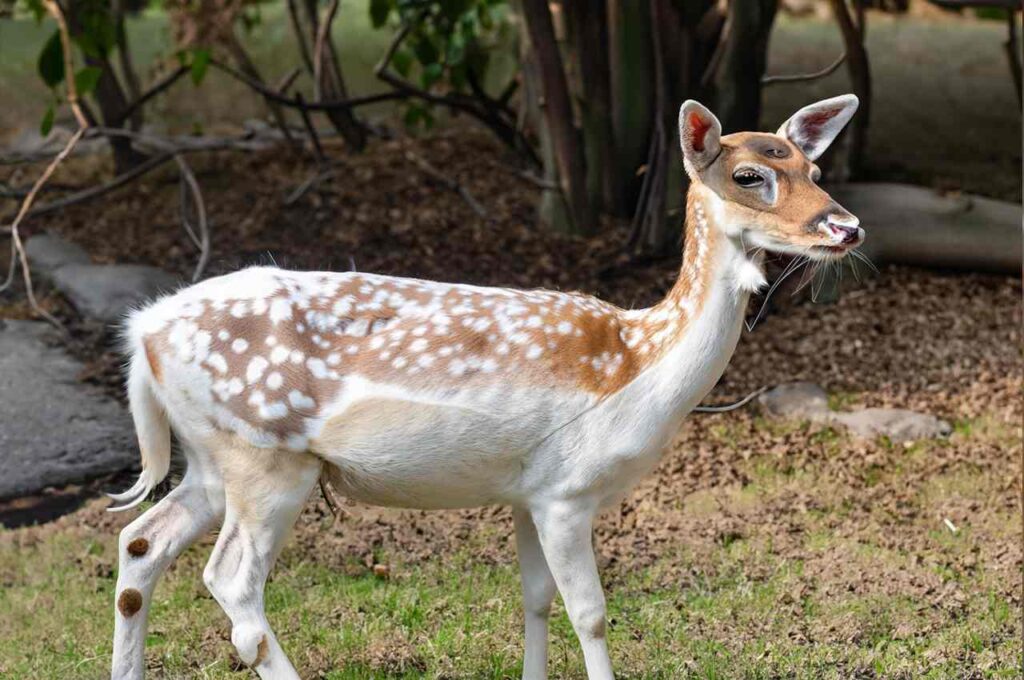
Cultural perspectives on piebald deer:
- Transition: Piebald deer were seen as spirits undergoing transition in Native American societies, representing fragility and change.
- Respect for Tradition: Piebald deer hunting was originally prohibited by Native American tribes because they believed it to go against their holy beliefs.
- Continued Influence: Some tribes still practice these customs today, highlighting the long-lasting impact of prehistoric cultural ideas.
| Cultural Aspect | Description |
|---|---|
| Native American Beliefs | Piebald deer are seen as spirits undergoing transition and represent vulnerability and change. |
| Sacred Tradition | The slaughter of piebald deer is usually prohibited by Native American tribes. |
| Continuing Influence | Some groups still practice these traditional customs today. |
Piebald Deer in Hunting: Ethical Considerations
The ethical debates surrounding hunting have become more difficult as a result of the existence of piebald deer. The morality of the need for regulation of hunting piebald deer is a topic that both hunters and conservationists often debate.
Ethical Aspects of Piebald Deer Hunting:
- Superstitions and Myths: In the past, some hunters held the belief that coming across a piebald deer may be unlucky and result in hunts being abandoned.
- Value as prizes: Due to superstitions, some hunters avoid approaching piebald deer, while others see them as rare prizes.
- From the standpoint of conservation: There are still arguments on both sides of the question of whether hunting piebald deer should be prohibited or permitted.
| Ethical Aspect | Description |
|---|---|
| Superstitions and Myths | Historically held notions that seeing a piebald deer might be unlucky. |
| Value as Trophies | Divergent viewpoints among hunters on the special significance of piebald deer. |
| Conservation Perspective | Ongoing discussion on the legality or appropriateness of hunting piebald deer. |
Management and Conservation of Piebald Deer
Piebald deer conservation is a difficult endeavor since it necessitates balancing the requirement for appropriate deer population management with the special genetics and cultural value of these animals.
Approaches to Piebald Deer Conservation:
- Preservation: Proponents of preservation contend that piebald deer contribute to biodiversity and should be preserved for the enjoyment of future generations.
- Management: According to some, ethical deer management and hunting may reduce genetic problems and preserve a healthy deer population.
- Local rules: Different states have particular rules protecting piebald deer, while others do not. Hunting laws vary depending on where you are.
| Conservation Approach | Description |
|---|---|
| Preservation | Supports piebald deer conservation for biodiversity and culture. |
| Responsible Management | To address genetic concerns and ensure population health by hunting and managing piebald deer. |
| Local Regulations | Local hunting rules, include piebald deer protection in several jurisdictions. |
The Rarity and Remarkability of Piebald Deer
In conclusion, piebald deer are a rare and alluring phenomena in the natural world, the consequence of a special genetic variant that produces beautiful coat patterns. Whether in the contexts of conservation, hunting, or cultural iconography, their presence inspires both awe and discussion.
Piebald deer continue to arouse awe and amazement as examples of nature’s living masterpieces and serve as a constant reminder of the complexity and wonders of our own wildlife. These unusual animals are proof of the variety and beauty of the natural world, whether you come across one in the wild or admire it from a distance.
Reasons for Rarity
Piebald deer are rare due to two major factors:
- Genetics: Piebaldism is a rare recessive characteristic that only occurs when both parents have it.
- Camouflage: White coats are not camouflaged with their surroundings, making piebald deer easy prey for predators.
Even yet, seeing a piebald deer is still a very rare wildlife sighting!
Frequently Asked Questions
How rare is a piebald deer?
Piebald deer make up fewer than 2% of white-tailed deer. They have stunning colour patterns, frequently with white hair on their fur. Since these patches vary in size and distribution, piebald deer look different. Some have practically pure white coats with little brown spots, while others have white patches among their marks. Piebald deer may have arched spines, malformed hooves, reduced jaws, and small legs. Although rare, piebald deer are not as rare as pure albino deer, which are white with pink eyes, nose, and hooves. Piebald deer are unusual and intriguing because true albino deer are scarce in the wild.
What causes a deer to be piebald?
Piebald deer have an uncommon genetic abnormality that may cause moderate to severe coat colour and skeletal alignment defects. This recessive trait may need both parents to possess it to produce piebald fawns. The piebaldism gene controls melanin synthesis, which gives animals their color. This gene reduces melanin in piebald deer, resulting in colorlessness. This pleiotropic gene affects several features beyond coat abnormalities. Thus, piebald deer may have bent spines, shorter or twisted legs, noses, internal organ abnormalities, and shortened jaws. Hunters witness deer with lesser signs, while some may have dwarfism or arched spines. This unusual genetic defect impairs melanin synthesis, giving piebald deer their distinctive look and associated abnormalities.
Are piebald deer healthy?
Due to their genetic abnormality, piebald deer might have modest to severe health difficulties. Some piebald deer have dwarfism or arched spines, while others have merely white hair patches. These deer might have hearing loss, digestive system malformations, jaw abnormalities, and hormone issues. They may also have bent spines, malformed limbs, curved noses, internal organ anomalies, and reduced jaws due to bone growth. Hunters see milder-symptomed deer, which live regular lives. Piebald deer are not albinos and make up fewer than 2% of white-tailed deer.
What is the rarest deer?
The Philippine Visayan Islands’ Visayan spotted deer is the world’s rarest deer species. It is endangered by the International Union for Conservation of Nature (IUCN), with just 2,500 adult individuals living. Their fate in the wild is questionable. Since 1991, Visayan spotted deer habitat has deteriorated, practically overlapping with Visayan warty pig habitat. This deer is one of the tiniest in the world, at 60–70 cm tall. Key, Little red brocket, Northern pudu, and Chinese water deer are also scarce. Piebald deer make up fewer than 2% of the white-tailed deer population, but pure albino deer are very rare.
Are piebald deer deaf?
Piebald deer are not deaf, but their coat pattern increases their risk of hearing loss. An hereditary genetic abnormality in skin pigment-producing cells causes this unusual coat pattern. Some piebald deer may have hearing impairment due to this gene, according to research. Not all piebald deer are deaf; some can hear. In conclusion, piebald deer have a higher chance of hearing loss due to their coat type, although not all do.
Are piebald deer good luck?
Different cultures and people associate piebald deer with luck. Some tribes, especially Native Americans, revere piebald deer and think they bring luck. In contrast, some hunters believe shooting a piebald buck would bring bad luck. These beliefs are based on cultural superstitions and folklore, not science. Importantly, piebald deer are not a different species and do not bring luck. Some civilizations venerate these unusual creatures for their looks and meaning.
Can piebald deer have babies?
Piebald deer may reproduce. It is thought that both parent deer must contain the recessive gene to produce piebald fawns. These deer may breed and raise piebald and normal fawns. Piebald deer and “normal” deer may breed and have offspring with different coat patterns, therefore combining them is usually OK.
Is shooting a piebald deer bad luck?
No empirical evidence supports the notion that shooting a piebald deer brings ill luck. Some hunters avoid piebald deer owing to their rarity, while others believe harvesting them is lucky. Piebald deer may breed like other deer, thus killing one is lucky or unlucky depends on personal belief and superstition.
Do piebald deer have red eyes?
Albino deer have pink or crimson eyes, noses, and hooves owing to their lack of pigmentation. Piebald deer do not. Piebald deer have black hooves and brown noses and eyes. Although not albinos, they have a peculiar coat pattern with white hair splotches on their face and legs. An hereditary genetic abnormality in skin pigmentation cells causes this pattern. With varied levels of white hair, piebald deer frequently have arched spines, malformed hooves, reduced jaws, and small legs.
How common are piebald whitetail deer?
Piebald whitetail deer make up fewer than 2% of the population. They have unusual coat patterns with varied quantities of white hair and physical deformities include arched spines, malformed hooves, reduced jaws, and short legs. To get piebald fawns, both parents must have the recessive gene. Although rare, piebald deer may breed and have normal fawns. They are an interesting portion of the white-tailed deer population since they are not unusual like albino or leucistic deer.
What do Native Americans believe about piebald deer?
Native Americans respect piebald deer as spirits crossing the earthly and spiritual realms. The presence of these deer, which bring transformation, is revered. Some Native Americans believed killing piebald deer was bad luck because they were spiritual and magical. The cultural importance of piebald deer in Native American societies is reflected in these folklore and superstitions.
Conclusion
In conclusion, “What is a piebald deer?” they are fascinating animals with their white fur patches in their pigmented coats due to piebaldism. This characteristic is most frequent in white-tailed deer, although other deer species may have it. Piebald deer are rarer than albino deer, yet their beauty captivates nature aficionados. A distinctive appearance might also make them more susceptible to predators. It’s important to treat them with respect and caution in the wild. Piebald deer represent the diversity and remarkable beauty of nature, reminding us to appreciate and protect it.
- California Deer Hunting Guide: Seasons, Rules, Permits, and More - 26 June 2024
- Arkansas Deer Season 2024 [Schedules, Licenses, Bag Limits & More!] - 26 June 2024
- 2024 Arizona Deer Season New Dates & Rules! - 25 June 2024
